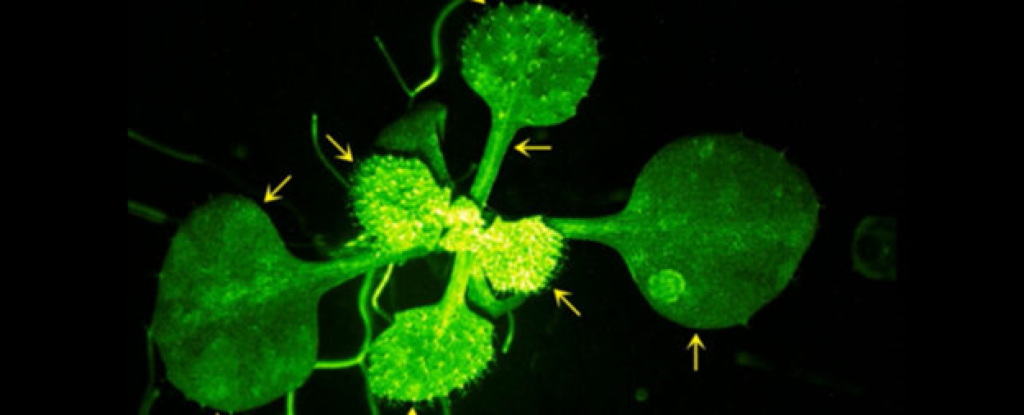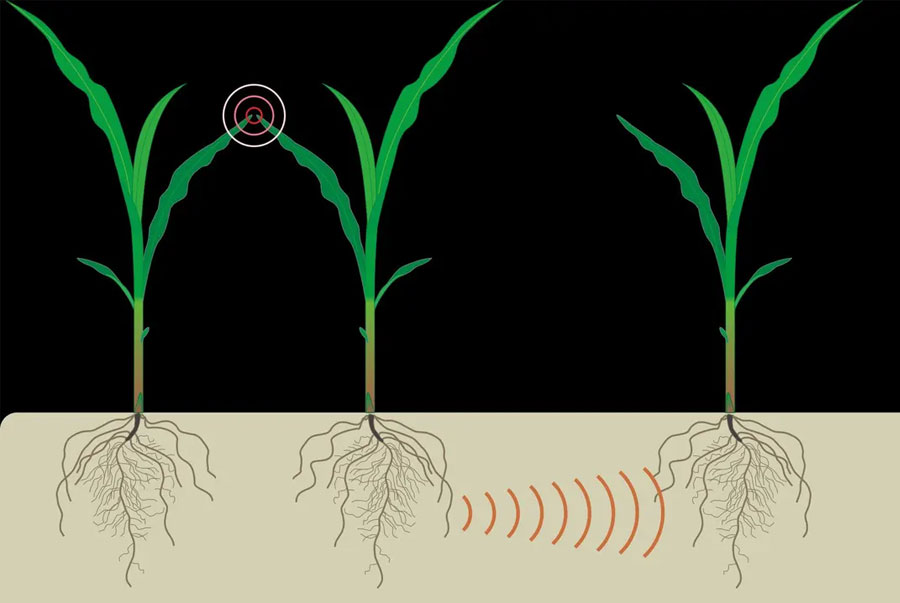Yes! Why not? Just see the figure below as seeing is believing.

Mustard plants respond to airborne danger indicators released by another plant: courtesy Aratani et al., Nature.
Hi readers! Do you believe in what you are seeing above? Amazing, isn’t it?
فَبِأَىِّ ءَالَآءِ رَبِّكُمَا تُكَذِّبَانِ
And what blessing (and actions) of Allah will you deny?
On January 15th, 2024, Nature published an article by Clare Watson (please read full article at the link below),saying that,
“Plants communicate to each other through an invisible fine mist of airborne compound surrounding them which can be a smell of these compounds that repel herbivores to protect themselves. This is one of the defense systems that scientists have known since 1980. However, recently, Japanese researchers has deployed real-time imaging techniques to exposed how plants receive and respond to these aerial alarms”.
In this study, conducted by molecular biologists together with their their colleagues at Saitama University in Japan, prepared a pump to transfer compounds emitted by injured and insect-riddled plants onto their undamaged neighbors, and a fluorescence microscope to watch what happened.
Caterpillars were set upon leaves cut from tomato plants and Arabidopsis thaliana (common weed in the mustard family), and took image of the responses of a second, intact, insect-free Arabidopsis plant to the danger indicators. The Arabidopsis Plants used here were genetically engineered as their cells contained a biosensor that shine green when an influx of calcium ions (which human cells use to communicate to each other) was detected.
The team used a similar technique to measure calcium signals in a study conducted in 2023, of fluorescent Mimosa pudica plants, which quickly move their leaves in response to touch, to avoid predators.
Japanese scientists used same technique to visualize how plants responded to the volatile organic compounds (VOC) released within seconds after the plants gets wounded.
Volatile organic compounds (VOC) have a high vapor pressure and low water solubility, are human-made chemicals produced in the manufacturing of paints, pharmaceuticals, and refrigerants or by-products produced by chlorination in water treatment, such as chloroform.
VOCs are often components of petroleum fuels, hydraulic fluids, paint thinners, and dry-cleaning agents and can also be common ground-water contaminants (substance that makes things impure).
Common examples of VOCs that may be present in our daily lives are benzene, ethylene glycol, formaldehyde, methylene chloride, tetrachloroethylene, toluene, xylene, and 1,3-butadiene.
It was not a natural but a manmade setup, the compounds were concentrated in a plastic bottle and pumped onto the recipient plant at a constant rate allowing the researchers to analyze what compounds were in the pungent mix.
The undamaged plants received the messages of their injured neighbors and responded with bursts of calcium signaling that moved across their outstretched leaves (you can see the video in the original paper by visiting the at (https://www.youtube.com/watch?v=hd-h_y1X4oA)

Airborne warning messages
and found two compounds called Z-3-HAL and E-2-HAL that induced calcium signals in Arabidopsis. They also identified for the first time, which cells are first to respond to the danger singles in Arabidopsis plants engineered with fluorescent sensors and those were exclusively happened to be guard, mesophyll, or epidermal cells.
Guard cells on plant surfaces form stomata.
(Stomata are the small pores that open up to the atmosphere when plants “breathe” in CO2. Mesophyll cells are the inner tissue of leaves, and epidermal cells are the outermost layer or skin of plant leaves).
When Arabidopsis plants were exposed to Z-3-HAL, guard cells generated calcium signals within a minute, after which mesophyll cells picked up the message and spread through epidermal cells and stomata.
Stomata are considered “nostril” of the plants as pre-treating plants with a phytohormone that shuts stomata significantly reduced calcium signaling.
“The story revealed when, where, and how plants respond to airborne “warning messages from their threatened neighbors” says, Masatsugu Toyota, a molecular biologist at Saitama University in Japan and senior author of the study.
“The ghostly communication network, that is hidden from our eyes, plays a pivotal role in safeguarding neighboring plants from imminent threats in a timely manner.”
Gaston Bachelard: a French philosopher who made tremendous contributions in the fields of poetics and the philosophy of science once said,
“the characteristic of scientific progress is our knowing that we did not know.”
Did you see, dear readers, how people think and work? Education developed curiosity in such people that produced wounders over time. What are we up to? Think about that.
See you next week. Take care,
Bye






One Comment
Farooq e Azam
January 24, 2024 at 3:36 amVery informative and interesting. Indeed there is some sort of communication between different components of an ecosystem e.g., plants and rhizospheric microbes. A good example of such interaction is nitrogen fixing microbes (Rhizobia etc) and leguminous plants. The interaction os highly specific and cannot occur between non-compatible partners